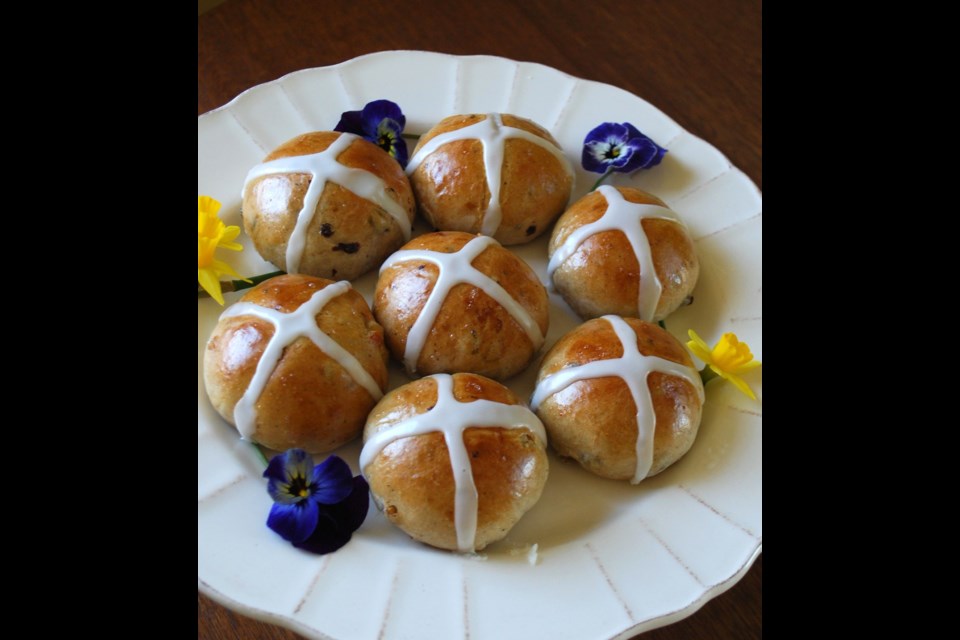Every year, before Easter, readers send me notes asking if I have a recipe for hot cross buns. I do, and I published it years ago. For those who missed it then or lost the clipping, here’s an updated version.
My recipe is traditional in style and yields fairly dense, semi-sweet buns rich with milk, butter, eggs, spices, currants and mixed peel. Alongside that recipe, I’ve included a few preparation photos above to help guide you when making them.
When this type of bun began to be enjoyed in England in the late 1600s, they were called Good Friday buns, marked with a cross to symbolize the religious importance of that occasion. They were given that name because they were meant to be eaten only on Good Friday.
That, of course, changed and in England and other places these buns are now enjoyed, they eventually became known as hot cross buns. In days of yore, that handle made them easier for vendors to loudly declare their buns were ready for purchase and also inspired the nursery rhyme Hot Cross Buns.
The cross on the bun is sometimes made, before baking, with narrow strips of pastry or with a thick paste made of flour and water. The cross can also be applied after baking, as I did in my recipe, with a thick mix of icing sugar and milk. I like this method because the brilliant white cross really stands out against the rich, golden bun.
Hot Cross Buns
This recipe yields 20, about three-inch-round hot cross buns with a delightful mix of sweet, spicy and fruity flavours. The dough is dense and heavy and best made in a stand mixer, but it is possible to mix and knead it by hand if you have strong arms.
Preparation time: 60 minutes, plus rising time
Cooking time: 20-22 minutes, per sheet of buns
Makes: 20 buns
Ingredients
3/4 cup homo milk
3/4 cup granulated sugar
1/4 cup butter
1/2 tsp salt
1/2 cup lukewarm water (not hot)
2 (8 gram) packets, or 4 1/2 tsp, active dry (traditional) yeast
1 large egg plus 1 large egg yolk, beaten
3 3/4 cups all-purpose flour
1 tsp ground cinnamon
1/4 tsp ground cloves
1/4 tsp ground nutmeg
1/2 cup currants or small raisins
1/2 cup chopped mixed peel
1/2 to 1 cup all-purpose flour
• vegetable oil
1 large egg white mixed with 1 Tbsp water
4 tsp milk
3/4 to 1 cup icing sugar
Method
Place milk in a small pot, set over medium heat and bring to the scalding point (just below a boil). Whisk in granulated sugar, butter and salt. Remove from the heat and stir until sugar is dissolved and butter is melted. Cool this mixture until lukewarm.
Place lukewarm water and yeast in the bowl of your stand mixer fitted with the dough hook. Let stand five minutes to dissolve the yeast. Now mix in the milk mixture and beaten egg and egg yolk.
Place the 3 3/4 cups flour, spices, currants and mixed peel in a second bowl and mix to combine. Add the flour mixture to the yeast mixture and mix until well combined. Add some or all of the remaining 1/2 to 1 cup flour until a smooth, somewhat sticky dough forms. Mix and knead the dough four minutes.
Lightly oil a bowl large enough to hold the dough. Turn the dough onto a lightly floured surface and gather into a ball. Set the dough in the bowl, tent with plastic wrap and set in a warmish (22C-22C), room temperature, draft-free place until about double in size, about 75 to 90 minutes.
Turn the dough back onto a lightly floured surface and cut in half. Shape each piece of dough into a 10-inch-long roll. Cut one of the rolls into 10 even pieces. Roll each piece of dough, on a flour-free part of your work surface, into a smooth ball and set on a non-stick or parchment paper-lined baking sheet. Using the back of a knife, firmly mark a 1/2-inch-deep cross into the top of each bun.
Loosely tent the buns with plastic wrap and let rise 75 minutes (they’ll be about 1 1/2 to two times their original size and will rise further once in the hot oven). Repeat these steps with the other half of the dough, placing the buns on a second baking sheet.
Preheat the oven to 375 F. Uncover the first sheet of buns and lightly brush them with egg-white mixture. Bake for 12 minutes, and then brush the buns again with egg-white mixture. Bake 8-10 minutes more, or until puffed and rich, golden brown in colour. Repeat these steps with the second sheet of buns, then cool the buns on a baking rack to room temperature.
Place the 4 tsp of milk in a small bowl and slowly mix in the icing sugar, stopping when you get a thick paste that’s still fluid enough to pipe. Spoon the mixture into a small piping bag fitted with a small, plain tip. Pipe a cross on the buns following the markings you made. Allow the icing to set for 30 minutes or so, and the buns are ready.
Eric’s option: If you make the dough in the evening, once you have formed the buns and marked a cross into them, they could be tightly wrapped and refrigerated. The next morning, take them out of the refrigerator two or so hours before you want to bake them. Loosen the plastic wrap so they’ll be able to rise. Because you’ll be starting from cold, let them rise about 90 minutes to two hours, then bake and finish as described in the recipe.
Eric Akis is the author of eight cookbooks. His latest is The Great Rotisserie Chicken Cookbook (Appetite by Random House).



